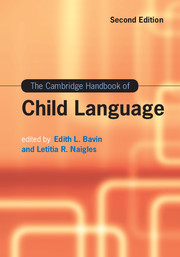Book contents
- The Cambridge Handbook of Child Language, second edition
- Cambridge Handbooks in Language and Linguistics
- The Cambridge Handbook of Child Language
- Copyright page
- Contents
- Figures
- Tables
- Contributors
- Book part
- 1 Introduction: perspectives on child language
- Part One Theoretical and methodological approaches
- Part Two Early developments
- Part Three Phonology, morphology and syntax
- Part Four Semantics, pragmatics and discourse
- Part Five Varieties of development
- Part Six Reading
- References
- Index
- References
Part Five - Varieties of development
Published online by Cambridge University Press: 05 November 2015
- The Cambridge Handbook of Child Language, second edition
- Cambridge Handbooks in Language and Linguistics
- The Cambridge Handbook of Child Language
- Copyright page
- Contents
- Figures
- Tables
- Contributors
- Book part
- 1 Introduction: perspectives on child language
- Part One Theoretical and methodological approaches
- Part Two Early developments
- Part Three Phonology, morphology and syntax
- Part Four Semantics, pragmatics and discourse
- Part Five Varieties of development
- Part Six Reading
- References
- Index
- References
- Type
- Chapter
- Information
- The Cambridge Handbook of Child Language , pp. 481 - 658Publisher: Cambridge University PressPrint publication year: 2015
References
Suggestions for further reading
Suggestions for further reading
Suggestions for further reading
Suggestions for further reading
Suggestions for further reading
Suggestions for further reading
The following reviews provide a useful summary of language and communication skills in DS and WS:
Mervis, C., & Becerra, A. (2007). Language and communication development in Williams Syndrome. Mental Retardation and Developmental Disabilities Research Reviews, 13, 3–15.
Kent, R., & Vorperian, H. (2013). Speech impairment in Down syndrome: A review. Journal of Speech Language and Hearing Research, 56, 178–210.
For further reading on the study of brain structure in WS and DS, see:
Haydar, T., & Reeves, R. (2012). Trisomy 21 and early brain development. Trends in Neurosciences, 35, 81–91.
Jackowski, A., Rando, K., Maria de Araujo, C., Del Cole, C., Silva, I., & Tavares de Lacerdaa, A. (2009). Brain abnormalities in Williams syndrome: A review of structural and functional magnetic resonance imaging findings. European Journal of Paediatric Neurology, 13, 305–16.
For a detailed description of the developmental trajectories methodology:
Thomas, M., & Annaz, D., Ansari, D., Scerif, G., Jarrold, C., & Karmiloff-Smith, A. (2009). Using developmental trajectories to understand genetic disorders. Journal of Speech Language and Hearing Research, 52, 336–58.



